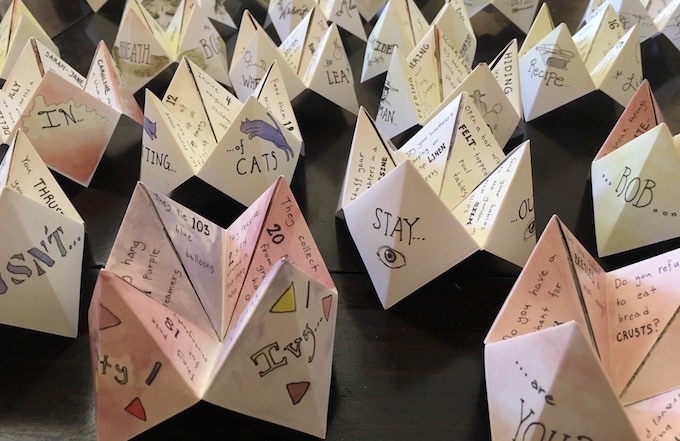Books & Culture
The Literature of Cootie Catchers
Fortunetelling games aren't just child's play—they're all about telling stories

There are soothsayers in the back of the school bus. Their hands move in familiar patterns: they fold a piece of notebook paper in half, then again, tuck the corners toward center and crease. As they work, a small apparatus manifests, pleated and primped. It begins to move. It opens. It closes. It reveals your future.
Perhaps it’s been years, decades, since you’ve enacted these motions yourself: first, choose a color from the outside flaps, and the soothsayers speak the letters aloud while widening and shutting the device’s pointed mouth, a soft crinkling of paper swishing through the hushed air. Now choose a number from the inner folds. Five? Alright, whisper the soothsayers, one, two, three, four, five, they count, as their hands twitch in tandem. Pick again. Seven? The flap levitates open, and there, hidden beneath the innermost paper petal, lies your fate.
Yes, this is familiar. A dream or a question, just on the edge of your memory: the nostalgic step by step ritual of playing with a paper cootie catcher.

You may have known the device by another name— “fortune teller” is the most common alternative, though certain regions also favor salt-cellar, whirlybird, chatterbox, or snapdragon, among others. There’s Poland’s “niebo-pieklo,” Germany’s “himmel und hölle,” Italy’s “inferno-paradiso”—all of which translate into some form of “heaven and hell.” “Cootie catcher,” itself, refers to one particular style of decorating the apparatus, in which small, scattered dots, or “cooties,” would be drawn on half the second-tier flaps, so that opening and closing the catcher would reveal or swallow them.
Regardless of its title, chances are you’ve used the cootie catcher just the way I did: as a two-person game designed to tell brief, randomized fortunes. Like most folk traditions, evolving and adapting under the influence of many thinkers and makers throughout time, the catcher’s true origins are unclear, with some accounts tracking them all the way back to 17th-century Europe. We do know that the device was popularized in the United States during the 1950s. From there, it bloomed into one of the nation’s most popular children’s folk traditions, right up there with Bloody Mary in the mirror and “light as a feather, stiff as a board.” Traveling onwards between friendship-braceleted hands, stuffed into pockets, and torn from diary pages, the cootie catcher spread across the world. And, as a child mystic requires only a single sheet of paper and a writing utensil to conjure one of these fold-up fortune tellers into existence, the toy was available to children of all income levels and classes. By its very design, the tradition could survive in any community, could manifest in any child’s hands.
I had nearly forgotten about cootie catchers until three winters ago in New Orleans. It was a friend’s 25th birthday, and we had (in a youthful burst of exuberance) transformed her shotgun apartment into a labyrinthine series of blanket forts. Lace and golden string lights were draped over chair backs. A tunnel led from the front door into the main quilt-muffled chamber, forcing party guests to make their entrance by squeezing into the room on hands and knees. As dusk slipped towards midnight and the wine ran low, we found ourselves recalling the blanket forts of our childhoods—and the strange occult happenings that shimmered inside them. Someone took out a piece of paper, tore it into a square, and began to fold.
Girls have long been drawn to games of chance, of luck, of peering into a future that seemed to already have been decided for them.
The cootie catcher is primarily associated with girlhood, a gendered tradition passed hand-to-hand at sleepover parties and in schoolyards. Like so many divinatory games, young women have long been the keepers and practitioners. In our patriarchal society, young men have been emboldened to select their own paths, to determine who and what they wanted to become—leaving boys with no true need for fortune telling or luck. Why bother with divination when you can control the future? Adolescent girls, however, were never afforded this promise. Thus, girls have long been drawn to games of chance, of luck, of peering into a future that seemed to already have been decided for them. If they couldn’t control the future, at least they could get a preview of what’s to come.
As a writer by trade, I’ll admit that I was immediately intrigued by the narrative qualities of the cootie catcher. Relying on a sort of “choose-your-own-adventure” storytelling format, the secrets hidden within the innermost flaps can be read in any order, as selected by the players themselves. The game-play relies on spelling (counting letters in a given word), as well as full sentences of language. Unlike visual mediums like palm reading or tea leaves, the cootie catcher is an outright literary form of fortune telling. And the catchers’ creators take on an authorial role, composing unique, original text to fill each fortune.
The further I examined this intersection between divination and literature, the more I found intrinsic ties between them. Countless examples of literary divinations began to unfold, not unlike (dare I say) the many layers of a cootie catcher. For example, take bibliomancy, in which a book (often a bible) is dropped and whatever page falls open portends the future. Or fortune cookies, containing tiny, prophetic koans. Or automatic writing, where a pen-toting medium allows a message to flow onto the page without conscious effort. All of which is to say—language is given extraordinary social and psychological power. This is beyond “the pen is mightier than the sword”: writing serves specifically as an occult power, a supernatural tool that must be wielded delicately. And the implication? Language can transcend time, slipping past us to peer into the future. While we’re trapped in a single moment, tied to our mortal bodies, words can scurry on ahead of us. And oddly, this makes sense—already, writing is viewed as a sort of time travel. Through language alone, we can meander through the mind of a long-dead author, accessing ideas and images from prior centuries. If writing can carry us into the past, can even transcend death, then why shouldn’t it carry us into tomorrow, too?
When the tarot was first popularized in Europe during the mid-15th century, it was not used for divination, nor for psychological insight. Like a standard poker deck, the tarot was simply a set of cards used in game play. Over time, it shape-shifted. The cards were shuffled and dealt and passed hand to hand, until they had transformed into tools for premonition. What was it about the tarot that allowed such a dramatic re-purposing? I’d argue that the tarot’s magical root is as simple as this: every card tells a story.
If something can tell a story, chances are that it can tell your story. The Fool who steps into the unknown… the Three of Swords bearing heartbreak… the patient, dangling Hanged Man… As any good writing teacher can tell you, the microcosm contains the macrocosm— within the tarot, we view an individual illustration and immediately it expands, jumpstarting associations with similar images in our own lives. And so, through these archetypal narrative images come tales. And tales lead to questions. And questions lead into the future.
If something can tell a story, chances are that it can tell your story.
The tarot and the cootie catcher are far from the only divinatory forms that succeed as not only literature, but as games as well. The Ouija board—a form of automatic writing— contains similar traits, yet evolved in the opposite direction of the tarot: it began as an occult tool called a “spirit board,” used by professional mediums during the American spiritualism movement. Only later, after Hasbro patented the first “Ouija board” in 1890, did it transform into a party game. Ouija provided a rare opportunity for young men and women to be intimate in public, unsupervised, as game play required users to sit close, knees touching, with hands overlapping on the planchette. Cootie catchers, too, involve partnership to operate, as does the tarot—all telltale traits of gaming form. And I believe it’s no coincidence that the Ouija board relies on the written word, spelled out letter by letter, to reveal its powers. Once again, language and divination find themselves hand in hand.
Remember the game where you open a can of soda and toggle the tab back and forth while reciting letters of the alphabet? Whichever letter the tab snaps loose on marks the first letter of your future spouse’s name. Similar patterns are seen in children’s jump rope games, where letters are counted off, and wherever the jumper trips up marks their future sweetheart’s identity. As with the cootie catcher, these are both traditionally feminine games– and as such, focus on one of the greatest, most influential unknowns young women faced: marriage.
It seems that everywhere we look, from the psychic’s velvet draped, neon-signed shop front, to Pepsi vending machines, to the foggy mythos of our own childhoods, language has been playfully divining our paths for centuries.
Of course, this inspiration can go both ways. Authors have often repurposed divinatory forms directly into works of literature. Pulitzer-winning poet James Merrill used a Ouija board to write his epic poem The Changing Light at Sandover. Italo Calvino wrote his novel The Castle of Crossed Destinies though tarot cards, which his two characters display to recount their tales. Lily Hoang’s book Changing was written using the I Ching. I found myself wandering a similar path at that ethereal blanket fort soiree in my friend’s New Orleans home, wondering how the cootie catcher might be re-worked into a storytelling tool. Over the course of the next few years, I collaborated with an illustrator to create a spooky tale told exclusively in a series of cootie catchers, each liftable flap bearing new narrative secrets and revelations. (If this sounds like your kind of thing, the bizarre and illustrious Ninepin Press has agreed to publish this miraculous object-set in its entirety—you can take a peek here).
Whenever I purchase a new journal, I flip through the blank pages cautiously. I can’t help but be suspicious of them. Soon, those pages will fill up with intimate, documentary words, boiling over with memories I haven’t yet lived through. The journal will contain so much I cannot yet know. In those early moments when a new journal is clean, crisp, unsullied by ink, I can’t help feel that the pages already sense what they’ll eventually hold. I squint over them, as if trying to read a note written in lemon juice. What does this paper know of the future that I cannot? How can I read past the limitations of my own body, into the writings I’ll scrawl tomorrow?
“Reading” is an essential act in divination. Even non-linguistic divinatory forms that focus on image or symbol rather than words are still spoken of like, well… literature. A seer doesn’t watch or glance or speak a palm—she “reads” it. Fortune tellers “read” tea leaves and tarot, despite the fact that these are all visual mediums of soothsaying, not word-based.
At its heart, divination is rooted in story.
The consistent use of “read” implies something important. It suggests an intrinsic link between divination and literature. At its heart, divination is rooted in story. And even if the tools being used are illustrations, or Earl Grey, or the wrinkles in your own hand, at the end of the day what matters are the stories these symbols tell us.
There are always new soothsayers in the back of the bus. There are always children peering forward from the beginnings of their lives, hungry to know what the vast future will bring. There will always be stories, and there will always be new ways of reaching past our own, mortal forms into the flickering future. However, each individual cootie catcher itself will not stand the test of time. These are no hardbound books, nor precious documents sealed away in museums. A cootie catcher is ephemera. It begins to dissolve in the very hands that create it. These art objects, these literary devices, these vital pieces of literature authored by young women are doomed to slip away just as quickly as the years themselves. They tear at the corners. They’re abandoned in schoolyards and tossed into wastebaskets. Far from treasured heirlooms, they exist in a moment of strange, supernatural ritual before being unceremoniously abandoned. Perhaps this is the cootie catcher’s greatest poignancy— as the school bus soothsayers grow and age and yearn towards womanhood, into the futures they dreamt of, their paper fortune tellers fall behind. Time gallops on. And as the predicted storms and joys arrive, the very objects that once envisioned these fates no longer exist to see it.








